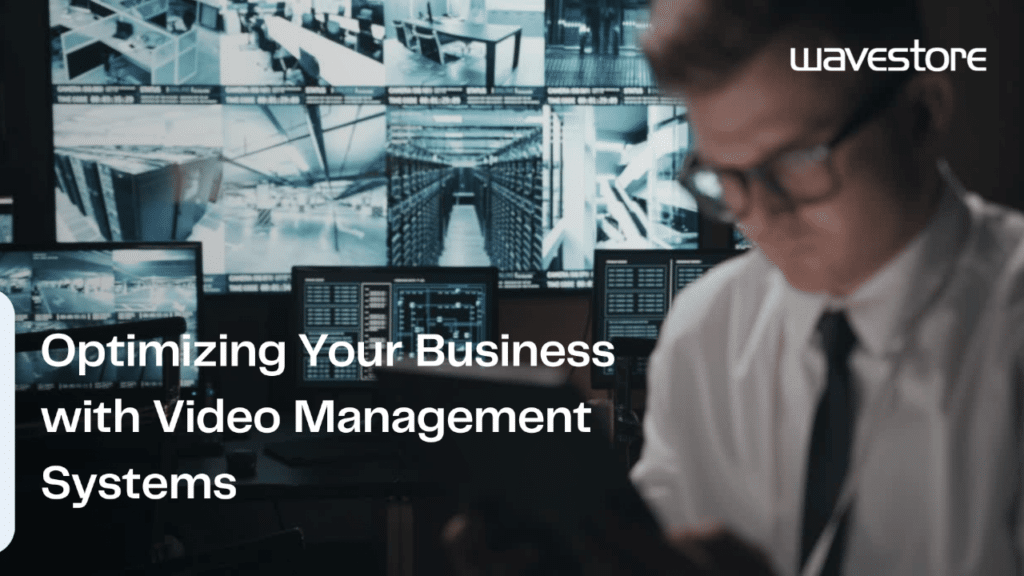Sebastian Marghella, Wavestore, believes one way to optimise your business and ensure its efficiency and security is through the use of Video Management Systems (VMS), as he explains here.
“Before diving into the benefits of VMS, it’s important to understand what they are. A Video Management System is a software platform that allows businesses to centrally manage and control their video surveillance systems. This includes recording, storing, and retrieving video footage from security cameras.
“A VMS acts as the command centre for your security cameras, providing a user-friendly interface where you can view live video feeds, playback recorded footage, and manage camera settings.
“With advanced features and functionalities, VMS helps businesses monitor their facilities, deter theft, and respond to security incidents effectively.
“One key aspect of a Video Management System is its scalability. Businesses can easily expand their surveillance network by adding more cameras and integrating them seamlessly into the existing VMS. This flexibility allows organisations to adapt to changing security needs and expand their coverage as their operations grow.
“Moreover, modern VMS solutions offer advanced analytics capabilities, such as motion detection, facial recognition, and object tracking. These features enable businesses to not only react to security events but also proactively identify potential risks and take preventive measures to enhance overall safety.
Key Features to Look for in a Video Management System
“When selecting a VMS for your business, it’s important to consider key features that will suit your specific needs. Look for a system that offers seamless integration with your existing security infrastructure and allows easy scalability as your business grows.
“Some essential features to look for include:
- High-quality video recording and playback capabilities
- Intelligent video analytics for advanced surveillance
- Remote access and mobile viewing options
- Robust data storage and retention capabilities
- Integration with access control and other systems for enhanced security
“Choosing a VMS with these features ensures that you have a comprehensive solution that meets your security requirements and future-proof your business.
How Video Management Systems Enhance Security and Surveillance
“Implementing a VMS in your business provides numerous benefits when it comes to security and surveillance. By having a centralized system for managing your security cameras, you can effectively monitor your premises and detect any security threats in real-time.
“With video analytics capabilities, a VMS can intelligently analyze video footage and alert security personnel to potential risks, such as unauthorised access or suspicious activities. This proactive approach to security allows for swift action and prevention of security breaches.
“Furthermore, the ability to access live video feeds and recorded footage remotely allows you to monitor your business even when you’re not on-site. Whether you’re traveling or managing multiple locations, a VMS gives you peace of mind and ensures that your business is always under surveillance.
Streamlining Operations: The Role of Video Management in Business Efficiency
“While security and surveillance are essential aspects of using a VMS, these systems also play a significant role in streamlining operational efficiency. By integrating your security cameras with other business technologies, such as access control or alarm systems, you can automate processes and reduce manual intervention.
“For example, when an alarm is triggered, the VMS can automatically send notifications to designated personnel and display the corresponding video footage. This saves time and enables quick response, minimizing disruptions and potential losses.
“In addition, video analytics features can provide valuable operational insights. By analysing people flow, customer behaviour, and occupancy data, businesses can optimise their layouts, staffing levels and marketing strategies. These actionable insights can positively impact your bottom line, boost customer satisfaction, and improve overall business performance.
Integrating Video Management Systems with Existing Technologies
“To fully leverage the power of a VMS, it’s crucial to integrate it seamlessly with your existing technologies. Whether you have an established security infrastructure or are starting from scratch, compatibility and interoperability are key factors to consider.
“A VMS should be able to integrate with various types of security cameras, regardless of the manufacturer or model. This ensures that you can utilise your existing camera assets and avoid costly replacements. Moreover, integration with access control systems and alarm systems allows for a centralised and synchronised security approach.
“When planning the integration, it’s important to work with a reputable provider that has expertise in both VMS and the technologies you currently use. Their knowledge and experience will ensure a smooth integration process and maximum benefits for your business.
Best Practices for Implementing a Video Management System
“When implementing a VMS in your business, there are some best practices to keep in mind to maximise its effectiveness:
- Define your objectives: Clearly outline what you want to achieve with the VMS implementation. Whether it’s improving security, enhancing operational efficiency, or both, having clear goals ensures a focused approach.
- Involve stakeholders: Engage key stakeholders from different departments to understand their requirements and get their buy-in. This collaborative approach ensures that the VMS meets the needs of the entire organization.
- Plan for scalability: Consider your business’s future growth and scalability needs. Make sure the chosen VMS can accommodate additional cameras and functionalities as your business expands.
- Provide comprehensive training: Ensure that your security staff is properly trained on using the VMS and its features. This empowers them to effectively operate the system and respond to security incidents.
- Regularly review and update: Ongoing monitoring and maintenance of your VMS is essential to keep it running smoothly. Regularly review system performance, update software, and conduct audits to address any potential vulnerabilities.
“Following these best practices sets your business up for a successful VMS implementation, maximizing the benefits and ensuring long-term success.
Measuring the ROI of Video Management Systems in Your Business
“One of the key concerns for businesses when adopting new technologies is the return on investment (ROI). Fortunately, evaluating the ROI of a VMS is relatively straightforward, as there are tangible benefits that can be measured.
“When calculating the ROI, consider factors such as:
- Reduction in security incidents and losses
- Increased operational efficiency and productivity
- Cost savings from streamlined processes
- Improved customer satisfaction and retention
“By quantifying these benefits and comparing them against the investment in the VMS, you can determine the ROI and gain a clear understanding of the system’s impact on your business’s bottom line.
Case Studies: Successful Video Management System Implementations
“No matter what industry you’re in, there are numerous real-world examples of businesses benefiting from VMS implementations. Let’s explore a couple of case studies to understand how these systems have made a difference:
- Retail Store Chain: A large retail store chain implemented a VMS across its multiple locations. The system allowed the security team to monitor the premises in real-time, leading to a significant reduction in theft and shrinkage. Additionally, the integration with the store’s access control system ensured that only authorized personnel could access sensitive areas, further enhancing security. You can read a case study here.
- Manufacturing Facility: A manufacturing facility upgraded its digital recording system and integrated it with a situation management software. This integration allowed for enhanced monitoring of production processes by analysing video footage and correlating it with production data. As a result, the facility improved security, identified inefficiencies, optimised workflows, and increased overall operational efficiency. You can read another case study here.
“These case studies demonstrate the practical application of VMS in different industries and highlight the measurable benefits they offer.
Future Trends in Video Management Technology
“As technology continues to advance, the future of VMS looks promising. Some of the key trends to watch out for include:
- Artificial Intelligence (AI) integration for advanced video analytics and predictive capabilities
- Cloud-based VMS solutions for anytime, anywhere access
- Integration with Internet of Things (IoT) devices and new security technologies for enhanced automation and data integration
- Improved cybersecurity features to protect against evolving threats
“Staying updated with these trends ensures that your business remains at the forefront of technology and continues to optimise its operations.
Overcoming Common Challenges in Video Management System Adoption
“While the benefits of VMS are clear, there can be challenges during the adoption process. It’s important to be aware of these challenges and plan accordingly to overcome them.
“Some common challenges include:
- Integration complexities with existing security infrastructure
- Resistance to change from employees or stakeholders
- Data storage and management considerations for large-scale deployments
- Choosing the right VMS provider and ensuring ongoing support
“By proactively addressing these challenges and working closely with a knowledgeable VMS provider, you can navigate the adoption process smoothly and reap the rewards of a modernised and optimised business.
Conclusion
“Video Management Systems offer a wide range of benefits for businesses looking to optimize their operations, enhance security, and improve their bottom line.
“By understanding the basics of VMS, identifying key features, and implementing best practices, businesses can leverage these systems to their advantage.
“With the rapid advancements in technology, VMS continues to evolve, offering innovative features and integration possibilities. By staying updated with industry trends and overcoming adoption challenges, businesses can unlock the full potential of VMS and thrive in an increasingly competitive business landscape.
“If you’re ready to take your business to the next level and optimize its efficiency and security, consider implementing a Video Management System. The benefits far outweigh the initial investment, and the positive impact on your business will be significant.”
To read more Wavestore news, click here.





